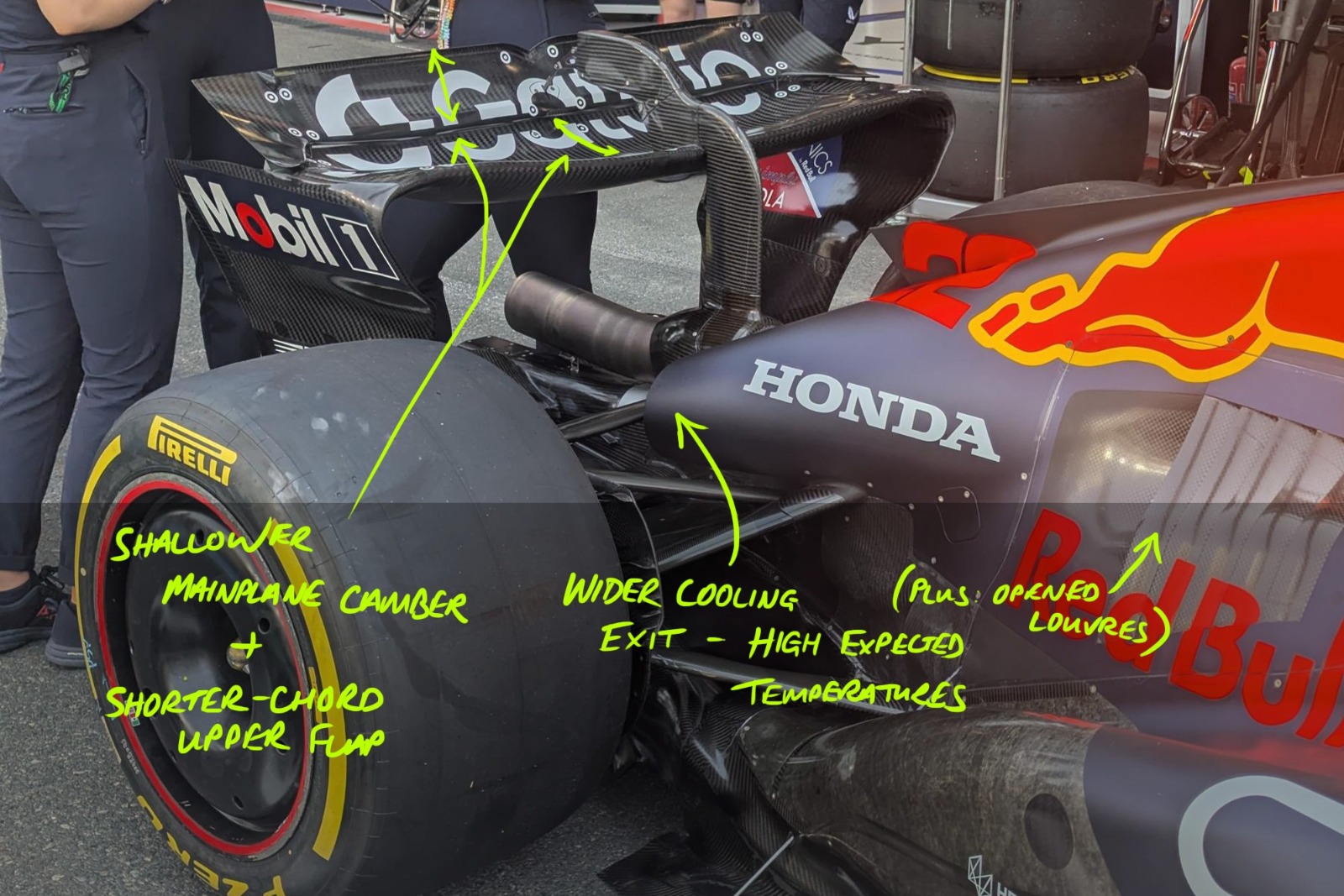In Formula 1 technical parlance, the “isochronal ratio” can be described as the ratio between lift (downforce being negative lift) and drag. At circuits like Jeddah, which has a plethora of high-speed corners and also multiple acceleration zones, the engineers tend towards setting their cars up for a “high isochronal” demand.
This involves attempting to dump as much drag as is feasible, without the expense of losing too much in the way of downforce. The downforce is still needed to navigate the high-speed corners around the Jeddah Corniche Circuit at an ideal velocity, allied to the traction out of Turns 1, 13, and 27, but this needs to be at greater efficiency to boost the top-end across the trio of DRS zones.
What we have is a series of teams opting to reduce the power of their rear wings slightly. They’ll continue to generate a sufficient level of downforce, and the trade-off in wing levels will be explored in practice to ensure the best compromise for both states, but they’ll be skinnier versus the medium-to-high downforce wings seen so far across the season.
It’s not a dissimilar set-up to Baku, where teams bring a few wings to determine the maximum level of downforce they can get away with shedding without it coming at the expense of lap-time.
There’s a few different ways to skin that cat, and it depends on how the teams want to use the overall span of the wing to balance downforce production and drag shedding. What tends to happen is that teams produce a ‘true’ low-downforce wing with a flatter mainplane surface and short-chord (length between front and rear edges) upper element, and then a slightly higher-downforce version where the mainplane is a touch more shapely.
Ferrari has opted for a skinnier upper flap than McLaren on its Saudi wings
Photo by: Filip Cleeren/Jake Boxall-Legge
And this is something that is visible in both the McLaren and Ferrari constructions here; the middle portion of the wing has a slight ‘divot’ at the point where the wing mounting is placed, as the central section of the wing is usually the point where the highest pressure differences are developed – hence generates the most downforce across the wing span.
This means that you can trim out the outboard-most sections of the rear wing, as these are the less efficient zones when you consider the ‘isochronal’ ratio to which the aerodynamicists adhere.
There are differences between the two wings here; McLaren has retained a longer-chord upper wing flap, but at a lower incidence (or angle of attack) – which reduces further with the mainplane twist at the outboard sections.
Ferrari, meanwhile, has opted for a slightly different trade-off; the mainplane has a longer chord length, but the upper flap is much ‘skinnier’ than the McLaren version.
Red Bull has chosen a slightly more conventional construction, producing something of a halfway house between a Monza-spec low-downforce wing and its usual mid-range wing; rather than the divot, there’s a more even ‘sag’ across the mainplane structure. Overall, camber is reduced to help cut drag, but there’s still enough incline to develop a decent level of downforce to settle the rear end. The upper flap is also of a slightly shorter chord length.

Red Bull’s tweaks are less extreme than McLaren’s and Ferrari’s
Photo by: Filip Cleeren/Jake Boxall-Legge
The team has also opened up some of the cooling outlets towards the rear of the car, simply to respond to the demands placed upon the powertrain by the Saudi Arabian heat.
Racing Bulls, Haas, and Aston Martin formally declared their lower-downforce rear wings in the pre-practice technical document circulated to teams and media, although all other teams have a lower-downforce variant to try. The teams will use the practice sessions to check the best compromise of downforce levels and set their wings up to accommodate that.
McLaren has also sought to inject a modicum of extra baseline downforce to its MCL39 with a new diffuser, pairing that with a new cluster of winglets mounted to the outside of the rear wheel hub. The team’s pre-event technical submission states that the diffuser “has been reshaped to improve overall flow conditioning in this area, with the aim of gaining aerodynamic performance”, and the “revised rear brake duct winglet arrangement results in an improvement in local flowfield around the rear corner translating to an increase in aerodynamic efficiency”.
In the fluorescent green corner, Sauber has been quietly – yet forcefully – adding to its upgrade cycle with more additions beyond the lower-downforce wing arrangement. The team has been reworking its floor piece by piece to extract more downforce and propel itself from the back of the grid, an approach its performance director Stefano Sordo spoke about at the Japanese Grand Prix.
“When we develop the floor, the floor is developed in stages – let’s say three stages. The first stage is the main surfaces, and then stage two and stage three, there are more of the details,” Sordo explained at Suzuka, as something of a preview of its current developments. “Stage two and stage three come later on, so you’ve got time to react to it. We try to bake in the time so that we can react to the issues of the car.”
In this article
Jake Boxall-Legge
Formula 1
Ferrari
Red Bull Racing
McLaren
Be the first to know and subscribe for real-time news email updates on these topics
Subscribe to news alerts
Read the full article here

